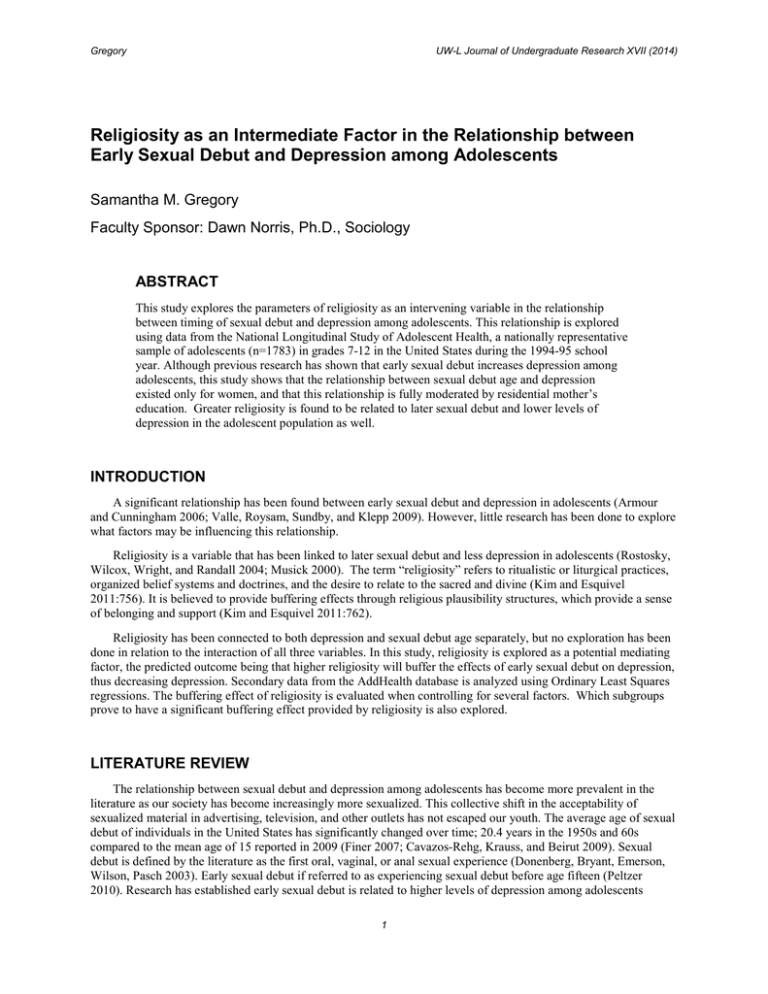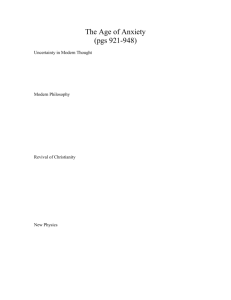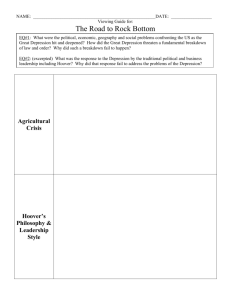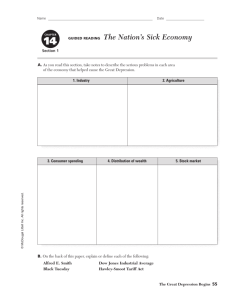
Gregory
UW-L Journal of Undergraduate Research XVII (2014)
Religiosity as an Intermediate Factor in the Relationship between
Early Sexual Debut and Depression among Adolescents
Samantha M. Gregory
Faculty Sponsor: Dawn Norris, Ph.D., Sociology
ABSTRACT
This study explores the parameters of religiosity as an intervening variable in the relationship
between timing of sexual debut and depression among adolescents. This relationship is explored
using data from the National Longitudinal Study of Adolescent Health, a nationally representative
sample of adolescents (n=1783) in grades 7-12 in the United States during the 1994-95 school
year. Although previous research has shown that early sexual debut increases depression among
adolescents, this study shows that the relationship between sexual debut age and depression
existed only for women, and that this relationship is fully moderated by residential mother’s
education. Greater religiosity is found to be related to later sexual debut and lower levels of
depression in the adolescent population as well.
INTRODUCTION
A significant relationship has been found between early sexual debut and depression in adolescents (Armour
and Cunningham 2006; Valle, Roysam, Sundby, and Klepp 2009). However, little research has been done to explore
what factors may be influencing this relationship.
Religiosity is a variable that has been linked to later sexual debut and less depression in adolescents (Rostosky,
Wilcox, Wright, and Randall 2004; Musick 2000). The term “religiosity” refers to ritualistic or liturgical practices,
organized belief systems and doctrines, and the desire to relate to the sacred and divine (Kim and Esquivel
2011:756). It is believed to provide buffering effects through religious plausibility structures, which provide a sense
of belonging and support (Kim and Esquivel 2011:762).
Religiosity has been connected to both depression and sexual debut age separately, but no exploration has been
done in relation to the interaction of all three variables. In this study, religiosity is explored as a potential mediating
factor, the predicted outcome being that higher religiosity will buffer the effects of early sexual debut on depression,
thus decreasing depression. Secondary data from the AddHealth database is analyzed using Ordinary Least Squares
regressions. The buffering effect of religiosity is evaluated when controlling for several factors. Which subgroups
prove to have a significant buffering effect provided by religiosity is also explored.
LITERATURE REVIEW
The relationship between sexual debut and depression among adolescents has become more prevalent in the
literature as our society has become increasingly more sexualized. This collective shift in the acceptability of
sexualized material in advertising, television, and other outlets has not escaped our youth. The average age of sexual
debut of individuals in the United States has significantly changed over time; 20.4 years in the 1950s and 60s
compared to the mean age of 15 reported in 2009 (Finer 2007; Cavazos-Rehg, Krauss, and Beirut 2009). Sexual
debut is defined by the literature as the first oral, vaginal, or anal sexual experience (Donenberg, Bryant, Emerson,
Wilson, Pasch 2003). Early sexual debut if referred to as experiencing sexual debut before age fifteen (Peltzer
2010). Research has established early sexual debut is related to higher levels of depression among adolescents
1
Gregory
UW-L Journal of Undergraduate Research XVII (2014)
(Armour and Cunningham 2006; Valle, Roysam, Sundby, and Klepp 2009). In knowing that this relationship exists,
the question one must pose is what intermediate factors may act to buffer the negative consequences for adolescents
today? I propose that religiosity may serve as an intermediary factor between sexual debut and depressions among
adolescents.
Before discussing this relationship it is important to have an understanding of the term religiosity. Religiosity
refers to ritualistic or liturgical practices, organized belief systems and doctrines, and the desire to relate to the
sacred and divine (Kim and Esquivel 2011:756). Several aspects of religiosity allow for it to serve as an intermediate
variable, most effectively the integrations of religiosity in the plausibility structure of religion.
Religiosity and Sexual Debut
Research has shown religiosity to be negatively related to likelihood and timing of coital (sexual) debut
(Rostosky, Scales, Regnerus, Wright 2003; Rostosky, Wilcox, Wright, and Randall 2004). Researchers have
interpreted this relationship by viewing religiosity as a protective factor for both coital (vaginal intercourse) and
noncoital (other forms of intercourse) sexual behaviors (Hull, Hennessy, Bleakley, Fishbein, and Jordan 2011). I
propose that this protective power comes from within religious plausibility structures.
Plausibility structures can be best understood through Berger’s writing: “The same human activity that produces
society also produces religion ... For the individual, existing in a particular religious world implies existing in the
particular social context within which that world can retain its plausibility” (1990:47;49). A church or religious
community may act as a broad base of reinforcement for an individual for values shared within that social structure
(Berger 1990:134; Krause 2002). Being involved with a religious plausibility structure provides buffering for
adolescents and a basis on which to process the social world. Social support found in these plausibility structures has
been found to directly decrease the likelihood of having had first sexual intercourse (Valle, Roysamb, Sundby,
Klepp 2009).
Social bonds can be formed within the plausibility structure with peers, community members, and family; these
bonds provide support for the individual. Peers play a major role in adolescents’ lives, as more time is devoted to
pursuing activities with friends outside of the home and peers’ opinions become increasingly important during this
stage of life (Krenke-Seiffge and Pakalniskiene 2010:991). Adolescents tend to group with similar individuals based
on common activities and use these groups as a reference for norms and standards. Religious youth tend to be
exclusive with friends and to prefer friendships with religiously similar people, which enforce social ties and
contribute to adolescents making positive choices amid negative peer influence (Cheadle and Schwadel 2012:1209;
Greir and Guidel 2010: 993; Adamcyk 2009). In reference to sexual debut, peers' religiosity influences adolescents'
coital debut even after accounting for the proportion of friends who have had sex (Adamcyk 2009).
Religious communities have been found to serve as protective networks of social support (Kim and Esquivel
2011:762). Regnerus and Elder state that “adolescents’ participation in religious communities...reinforces messages
about working hard and staying out of trouble, orients them toward a positive future, and builds a transferable skill
set of commitments and routines” (2003: 646). Involvement in religious communities is often measured through
attendance, frequent attenders being less likely to have had sex, had fewer partners, and had older age at sexual
debut (Edwards, Haglund, Fehrin, Pruszynski 2011).
Family plays the critical role in religious socialization in showing “acceptance of differing views of adolescents,
while guiding them to evaluate the pros and cons of diverse perspectives” (Bradshaw and Ellison 2008; Kim and
Esquivel 2011:762). It has been shown that “religion in the home is a major factor in the social acquisition of
adolescent religious values,” including values about sexual intercourse (Haight 1998: 220; Landor, Simons, Brody,
Gibbons 2011). In the exploration of Milwaukee, Wisconsin’s Adolescent Pregnancy Prevention Program, Azar
found that 46% of adolescents say that their parents are the biggest influence on their decisions about sexual activity,
while 80% say that it would be much easier to delay sexual activity and avoid adolescent pregnancy if they could
have open, honest conversations about these topics with their parents (2012:1838).
Religiosity and Depression
Religiosity and frequency of religious attendance have been found to be negatively associated with depression
(Musick 2000). Researchers identify religious groups as being a place where individuals can often receive emotional
support, formal aid and counseling, and other psychological resources (Ellison, Krause, Shepher, & Chaves 2009;
Krause 2008, Taylor & Chatters 1988; Chaves & Tsitos 2001; Neighbors, Musick, & Williams 1998; Trinitapoli,
Ellison, & Boardman 2009). Involvement in a religious group has been found to be linked to religious coping; the
cohesiveness of a congregation enhances the degree of support provided by church members, which in turn leads to
increase religious coping over time (Krause 2010). Religious coping is negatively associated with depression
(Eisenberg et al. 2011:845).
2
Gregory
UW-L Journal of Undergraduate Research XVII (2014)
Seiffge-Krenke, Aunola, and Nurmi define coping as “an active, purposeful process by which an individual
responds to stimuli appraised as taxing or exceeding his or her resources” (2009: 260). Religious or spiritual
adolescents often cope in times of stress by searching for significance in ways that are related to the sacred
(Pargament et al. 1998: 711). Religious coping can serve to moderate the association between stressor and mental
health either by buffering, in which deleterious effects of stress on mental health are weakened, or exacerbation, in
which the deleterious effects of stress are strengthened (Ellison 1994, Ellison, Henderson, Glenn, Harkrider 2011).
METHODS
Sample and Data
Data from the National Longitudinal Study of Adolescent Health (Add Health), a nationally representative
sample of adolescents in grades 7-12 in the United States during the 1994-1995 school year, was used. The first
Wave of data included a school administrator survey, adolescent in-school survey, adolescent in-home student
interview, and a parent interview. Data from the adolescent in-school survey, which was self-administered and
adolescent in-home student interview, which was administered by CAPI, were used for this study. 132 schools and
90,118 individuals participated in the adolescent in-school survey. 20,745 individuals were interviewed in-home.
This study is exempt from IRB approval because it involves using a secondary data set. The data set is publicly
available, previously collected by another party, and non-person identifiable.
Measures: Independent Variable
Sexual Debut. This variable was calculated using the birth year and debut year variables. Birth year (H1GI1Y)
was recoded (74= 1974, 75=1975, 76=1976, 77= 1977, 78=1978, 79=1979, 80=1980, 81=1981, 82=1982, 83=1983,
96=system missing). Debut Year (H1CO2Y) was also recoded (77= 1977, 78=1978, 79=1979, 80=1980, 81=1981,
82=1982, 83=1983, 84=1984, 85=1985, 86=1986, 87=1987, 88=1988, 89=1989, 90=1990, 91=1991, 92=1992,
93=1993, 94=1994, 95=1995, 96 Refused= System Missing, 97 Legitimate skip= System Missing, 98 Don’t know=
System Missing, 99 Not applicable= System Missing). Sexual Debut= birth year- debut year.
Dependent Variable
Depression. Depression among adolescents was calculated using the CES-D scale. Items from this dataset were
evaluated against those of the CES-D and were found to be comparable. Items included in the depression scale were
being bothered by things (H1FS1), having a poor appetite (H1FS2), having the blues (H1FS3), feeling just as good
as other people (H1FS4), having trouble keeping his/her mind focused (H1FS5), feeling depressed (H1FS6), feeling
too tired to do things (H1FS7), feeling hopeful about the future (H1FS8), feeling life had been a failure (H1FS9),
feeling fearful (H1FS10), feeling happy (H1FS11), talking less than usual (H1FS12), feeling lonely (H1FS13),
people being unfriendly to the individual (H1FS14), enjoying life (H1FS15), feeling sad (H1FS16), feeling people
dislike you (H1FS17), and feeling it is hard to start doing things (H1FS18). H1FS1, H1FS2, H1FS3, H1FS5, H1FS6,
H1FS7, H1FS9, H1FS10, H1FS12, H1FS13, H1FS14, H1FS16, H1FS17, and H1FS18 were recoded (0
never/rarely= 0 never/rarely, 1 sometimes= 1 sometimes, 2 a lot of the time= 2 a lot of the time, 3 most/all of the
time= 3 most/all of the time, 6 refused= system missing, 8 don’t know= system missing). H1FS4, H1FS8, H1FS11,
and H1FS15 were reverse coded (3 most/all of the time= 0 most/all of the time, 2 a lot of the time= 1 a lot of the
time, 1 sometimes= 2 sometimes, 0 never/rarely= 3 never/rarely, 6 refused= system missing, 8 don’t know= system
missing).
Mediating Variable
Religiosity. Religiosity was calculated using the variables frequency of service attendance in the past year
(H1RE3), importance of religion (H1RE4), frequency of prayer (H1RE6), and frequency of youth group attendance
in the past year (H1RE7). All variables were recoded (H1RE3: 4 never= 1 never, 3 less than once a month= 2 less
than once a month, 2 once a month or more/less than once a week= 3 once a month or more/less than once a week, 1
once a week or more= 4 once a week or more/less than once a week, 6 refused= system missing; H1RE4: 4 not
important at all= 1 not important at all, 3 fairly unimportant= 2 fairly unimportant, 2 fairly important= 3 fairly
important, 1 very important= 4 very important, 6 refused= system missing, 7 legitimate skip= system missing, 8
don’t know= system missing; H1RE6: 5 never= 1 never, 4 less than once a month= 2 less than once a month, 3 once
a month or more/less than once a week= 3 once a month or more/less than once a week, 2 once a week or more & 1
once a day or more= 4 once a week or more, 6 refused= system missing, 7 legitimate skip= system missing, 8 don’t
know= system missing; H1RE7: 4 never= 1 never, 3 less than once a month= 2 less than once a month, 2 once a
month or more/less than once a week= 3 once a month or more/less than once a week, 1 once a week or more= 4
3
Gregory
UW-L Journal of Undergraduate Research XVII (2014)
once a week or more, 6 refused= system missing, 7 legitimate skip= system missing, 8 don’t know= system
missing). To measure religiosity, this equation was used:
(Prayer + Youth Group Attendance + Religious Service Attendance) x Importance of Religion
Control Variables
Gender Gender (BIO_SEX) was measured in the AddHealth Dataset, however it contained a “refuse”
option, thus Gender was recoded (1 male= 1 male, 2 female= 2 female, 6 refused= system missing).
Race Race was coded as a dichotomous variable using the question that indicated respondents should mark
the box if they were white and skip it if they did not identify as white (H1GI6A). This variable was recoded (0
not marked= 0 non-white, 1 marked= 1 white, 6 refused= system missing, 8 don’t know= system missing).
Residential Mother’s Education Level Several measures of parental education level were available in the
AddHealth Dataset, however residential mother’s education level (H1RM1) was selected as a control for this
study as it was reasoned to have a higher affect than the other variables available (residential father’s education
level, biological mother’s education level, biological father’s education level). This variable was also recoded (1
8th grade of less & 10 she never went to went to school=1 8th grad or less , 2 >8th grade/didn’t graduate high
school=2 >8th grade/didn’t graduate high school, 3 business/trade/voc. school instead of high school=3
business/trade/voc. school instead of high school, 4 high school graduate=4 high school graduate, 5 GED=5
GED, 6 business/trade/voc. school after high school=6 business/trade/voc. school after high school, 7
college/didn’t graduate=7 college/didn’t graduate, 8 graduated from college/university=8 graduated from
college/university, 9 prof training beyond 4-yr college/university=9 prof training beyond 4-yr
college/university, 11 went to school/resp doesn’t know level= system missing, 12 resp doesn’t know if she
went to school= system missing).
Age (77= 1977, 78=1978, 79=1979, 80=1980, 81=1981, 82=1982, 83=1983, 84=1984, 85=1985, 86=1986,
87=1987, 88=1988, 89=1989, 90=1990, 91=1991, 92=1992, 93=1993, 94=1994, 95=1995, 96 Refused= System
Missing, 97 Legitimate skip= System Missing, 98 Don’t know= System Missing, 99 Not applicable= System
Missing)
Plan of Analysis
Descriptive statistics including mean, median, mode, and standard deviation were run for all variables above
(Table 1). Correlations were then run between all variables. OLS regression models were run for linear debut age for
all adolescents and linear debut age for males and females, respectively, to analyze the relationships between sexual
debut, religiosity, and depression. Tests for multicollinearity between control variables and linear shape of sample
were also conducted to ensure that neither multicollinearity nor a u-shaped curve were affecting the results.
Table 1a. Full sample descriptive statistics
Table 1b. Descriptive statistics for female respondents
4
Gregory
UW-L Journal of Undergraduate Research XVII (2014)
RESULTS
Adolescent Sexual Debut Age in Relation to Religiosity and Depression- Full Sample
Table 2 presents the relationship between debut age and depression (Model 1); debut age and depression when
controlling for gender, race, age, and residential mom’s education (Model 2); debut age, depression, and religiosity
when controlling for gender, race, age, and residential mom’s education (Model 3); and debut age, depression, and
religiosity when not factoring in the control variables (Model 4). Model 1 shows that debut age is not significantly
related to depression. Model 2 shows that debut age is significantly positively related to gender (p<.01), indicating
that females are more depressed, and that race and residential mom’s education are significantly negatively related
to depression (p<.05 and p<.01, respectively), indicating that non-whites and individuals with lower educated
residential mothers are more depressed. Model 3 shows that the significant relationships in Model 2 remain
significant when adding religiosity to the model. It also shows that religiosity is significantly negatively related to
depression (p<.01), indicating that individuals with higher religiosity are less depressed. Model 4 shows that
religiosity was not significantly related to depression, however, it became significant when adding in controls (as
shown in Model 3). In summary, for the full sample debut age did not significantly affect depression. Females, nonwhites, individuals with lower educated residential mothers, and individuals who had lower religiosity were more
depressed.
Table 2. Ordinary Least Squares Regression Showing Effects of Debut Age on Depression- Full Sample
Adjusted R-squared
.000
.048
.055
.000
Note: N= 1783. *p<.05. **p<.01. Unstandardized coefficients are presented with standard errors in the next column.
5
Gregory
UW-L Journal of Undergraduate Research XVII (2014)
Adolescent Sexual Debut Age in Relation to Religiosity and Depression- Female Respondents
Table 3 presents the relationship between debut age and depression (model 1); debut age and depression when
controlling for gender, race, age, and residential mom’s education (model 2); debut age, depression, and religiosity
when controlling for gender, race, age, and residential mom’s education (model 3); and debut age, depression, and
religiosity when not factoring in the control variables (model 4). Model 1 shows that debut age is significantly
negatively related to depression (p<.01), indicating that females with a lower debut age were more depressed. Model
2 shows that when controlling for residential mom’s education, which is significantly negatively related to
depression (p<.01), the relationship between debut age and depression is no longer significant. Model 3 shows that
residential mom’s education remains significantly negatively related to depression (p<.01), indicating that
individuals with less educated residential mothers were more depressed, and that religiosity is significantly
negatively related to depression (p<.05), indicating that individuals with higher religiosity have less depression.
Race also becomes significantly related to depression (p<.05). Model 4 shows that, when not controlling for
residential mom’s education, debut age remains significantly negatively related to depression (p<.01), and that
religiosity is not significantly related to depression. In summary, these data indicate that residential mom’s education
serves as a moderator in the relationship between depression and debut age. Females with less educated residential
mothers debuted earlier, and thus were more depressed. Religiosity is also significantly related to depression, but
does not mediate the relationship between debut age and depression. An Ordinary Least Squares Regression was
also run for the male sample, and for white and non-white participants, but no significant relationships were found
between debut age and depression.
Table 3. Ordinary Least Squares Regression Showing Effects of Debut Age on Depression – Female Subsample
Adjusted R-squared
.009
.031
.040
.006
Note: N= 920. *p<.05. **p<.01. Unstandardized coefficients are presented with standard errors in the next column.
Summary
Early sexual debut age only leads to higher depression for women. Religiosity also leads to lower depression for
women, but it does not mediate the relationship between debut age and depression. However, residential mom’s
education did serve as a moderator in the relationship between debut age and depression. These findings indicate
that residential mom’s education is the primary causal factor, meaning that mothers with less education have
children who debut earlier, and thus are more depressed.
6
Gregory
UW-L Journal of Undergraduate Research XVII (2014)
DISCUSSION
In today’s sexualized world, average age at sexual debut has been steadily decreasing (Finer 2007). At the same
time, we see high levels of depression, 1 in 5 teens having experienced clinically diagnosed depression (Duckworth
2010). Studies have found that earlier sexual debut has been linked to higher levels of depression (Armour and
Cunningham 2006; Valle, Roysam, Sundby, and Klepp 2009). Although research has linked high religiosity with
lower levels of depression (Musick 2000; Eisenberg et al. 2011:845) and later sexual debut (Edwards, Haglund,
Fehrin, Pruszynski 2011; Valle, Roysamb, Sundby, Klepp 2009), research has not explored how religiosity plays
into the relationship between sexual debut age and adolescent depression.
This study did not confirm the relationship between sexual debut age and depression that has been found by
others (Armour and Cunningham 2006; Valle, Roysam, Sundby, and Klepp 2009). Without this established
relationship, this study was unable to explore how religiosity factored in.
Several factors may have acted as limitations to this study, the first being the stigma that is attached to one’s
sexual debut. Depending on environmental factors, adolescents may have been affected to different degrees by the
stigma that sexual debut should occur when one is older or when one is married, thus reporting older ages than their
actual debut age. Respondents who were more affected by this stigma could be less likely to provide factual answers
in regard to their actual age at sexual debut.
Another limitation of this sample could be that the depression variable was positively skewed. With a small
sample of adolescents who were experiencing or had experienced depression (n=252), the exploration of other
variables like sexual debut age may have been affected. Concern about the effect of the skew is lessened, however,
by finding significance between debut age and depression for the female subsample.
Futhermore, the lack of use of longitudinal data limits the ability to establish causation in the relationship
between debut age and depression. It is not possible to establish whether early debut leads to depression or if
depression leads to early debut. Further exploration of this research question should include multiple waves of data
in order to imply as to causation. Moving outside of the initial research question, this study does show that females
with less educated mothers are likely to debut earlier and are also more depressed. This differs from the samples in
Armour and Cunningham’s 2006 study and Valle, Roysam, Sundby, and Klepp’s 2009 study, in that a relationship
was found regardless of gender. The inclusion of male participants, not the skew found in the depression variable,
masks any affect. Rather, it appears that the inclusion of male participants is what is masking the relationship
between debut age and depression.
Finally, it is very possible that the differences in findings about the association between religiosity and
depression is due to the variable being measured differently. In this study, an equation was built using existing
literature surrounding various aspects of religiosity. In Musick’s 2000 study, for example, church attendance was the
sole element measured to indicate religiosity (274). In the way that Musick’s study measured religiosity, we find that
the demographic description of an individual with high religiosity is an older, white female who had an educated
mother. One might speculate as to why this picture of a person with high religiosity is painted the way it is. Why not
a young African- American child who is raised in an environment where religious services of are high importance
and they are able to attend with parents or other community members who enforce these values? Or a man who acts
as head of the household and believes that the morals taught by religious institutions are beneficial to his children’s
moral development? I propose that with age comes an understanding what is important to a person, and this
religiosity measure included importance of religion. Also, women tend to be able to connect to things on a more
emotional level, and oftentimes religious institutions and beliefs have more charismatic and emotional components.
The findings revolving around female debut age and depression points to important future research
opportunities about the relationship between mother’s education and adolescent depression levels and debut age.
Researchers have already begun to explore how parental education affects offspring, finding that higher maternal
education leads to enrollment in higher quality early childhood education and care (Greenberg 2011); that low
parental education worsens health in children, especially in children who are also poorly educated (Ross and
Mirowsky 2011); and that more parent education is related to higher adolescent emotional intelligence (Harrod and
Scheer 2005).
7
Gregory
UW-L Journal of Undergraduate Research XVII (2014)
These findings aside, there is very little research that specifically focuses on the effects parent’s education may
have on depression. Parent education is most often considered a demographic variable and used as a control measure
rather than an independent variable (e.g., Dietz and Matthew 2011; Little, Welsh, Darling, and Holmes 2011). This
study shows that parent education, specifically residential mother’s education, has significant effects of the mental
health of their children, indicating that further research exploring the connection between parent education and
depression in offspring is needed.
Additional measures should also be taken to help decrease the levels of depression in youth. Programs
providing easily-accessible and high-quality education for parents, especially mothers, should be provided. An
opportune time to offer this education would be in tandem with the pre-natal, birthing, and post-natal care given to
mothers. This would ensure that education is offered to a majority of parents while their children are still young,
thus decreasing the likelihood that a low education would affect their child’s depression levels later in life.
Additionally, religious programming for children, especially females, that focuses on the importance of the beliefs
of that religion should be offered in order to decrease female depression levels in adolescence. This programming
could be offered through religious places of worship, or even through community centers.
Future research directions of interest include exploring the effects of residential father’s education on adolescent
depression in comparison to residential mother’s education. Also, alternate measures of religiosity should be
explored in relation to adolescent depression, evaluating this relationship longitudinally by using several waves of
the AddHealth data.
Using the 1995 wave of AddHealth data, the effects of religiosity on the relationship between early sexual debut
age and adolescent depression was explored. No relationship between debut age and depression was found,
however, high religiosity was related to lower depression, and residential mom’s education level was related to
debut age, which in turn affected depression levels. This brings to light the importance of providing educational
opportunities for mothers in order to produce better outcomes for their children.
REFERENCES
Adamczyk, Amy. 2009. "Socialization and Selection in the Link between Friends' Religiosity
and the Transition to Sexual Intercourse." Sociology of Religion 70(1): 5-27.
Add Health Database. 2002. National Longitudinal Study of Adolescent Health, Waves I, II, and
III, 1994­1996, 2000­2002 (ICPSR report). Retrieved from
http://www.icpsr.umich.edu/icpsrweb/ICPSR/studies/21600#scope
Armour, Stacy and Anna Cuningham. 2006. "Timing of Sexual Initiation and Adolescent
Depression." Conference Papers­ American Sociological Association 19.
Azar, Beth. 2012. “Adolescent Pregnancy Prevention Highlights from a Citywide Effort.”
American Journal of Public Health 102(10): 1837-1841.
Berger, Peter L. 1990. The Sacred Canopy: Elements of Sociological Theory of Religion. New
York: Anchor Books.
Bradshaw, M., C. G. Ellison, and K. J. Flannelly. 2008. "Prayer, God Imagery, and Symptoms of
Psychopathology." Journal for the Scientific Study of Religion 47: 644-659.
Cavazos-Rehg, Patricia A., Melissa J. Krauss, and Laura Jean Bierut. 2009. "Age of Sexual
Debut among US Adolescents." Contraception 80(2): 158-162.
Chaves, M.A. and W. Tsitos. 2001. "Congregations and Social Services: What They Do, How
They Do it, and With Whom." Nonprofit and Voluntary Sector Quarterly 30: 660-683.
Cheadle, Jacob E. and Philip Schwadel. 2012. “The ‘Friendship Dynamics of Religion,’ or the
‘Religious Dynamics of Friendship’? A Social Network Analysis of Adolescents Who
Attend Small Schools.” Social Science Research 41(5): 1198-1212.
Dietz, Laura J. and Karen A. Matthews. 2011. “Depressive Symptoms and Subclinical Markers
of Cardiovascular Disease in Adolescents.” Journal of Adolescent Health 48(6):579-584.
Donenberg Ph.D., Geri R., Fred B. Bryant Ph.D., Erin Emerson M.A., Helen W. Wilson B.A.,
and Keryn E. Pasch B.A. 2003. “Tracing the Roots of Early Sexual Debut among
Adolescents in Psychiatric Care.” Journal of the American Academy of Child and
Adolescent Psychiatry 42(5): 594-608.
8
Gregory
UW-L Journal of Undergraduate Research XVII (2014)
Duckworth, Ken. 2010. “Mental Illness: Depression in Children and Adolescent Fact Sheet.”
National Alliance on Mental Illness. Retrieved from http://www.nami.org/Template.cfm?
Section=By_Illness&template=/ContentManagement/ContentDisplay.cfm&ContentID=88551.
Edwards, Lisa M., Kristin Haglund, Richard J. Fehring, and Jessica Pruszynski. 2011.
"Religiosity and Sexual Risk Behaviors Among Latina Adolescents: Trends from 1995 to
2008." Journal of Women's Health 20(6): 871-877.
Eisenberg, Nancy, Valeria Castellani, Laura Panerai, Natalie D. Eggum, Adam B. Cohen,
Concetta Pastorelli, and Gian Vittorio Caprara. 2011. “Trajectories of Religious Coping
from Adolescence into Early Adulthood: Their Form and Relations to Externalizing
Problems and Prosocial Behavior.” Journal of Personality 79(4):841-873.
Ellison, C. G. 1994. "Religion, the Life Stress Paradigm, and the Study of Depression." In J.S.
Levin (Ed.), Religion in Aging and Health (pp. 78-121). Thousand Oaks, CA: Sage. Ellison, C.G., N. Krause,
B.C. Shepherd, and M.A. Chaves. 2009. “Size, Conflict, and
Opportunities for Interaction: Congregational Effects on Members’ Anticipated Support
and Negative Interaction.” Journal for the Scientific Study of Religion 48:1-15.
Ellison, Christopher G., Andrea K. Henderson, Norval D. Glenn, Kristine E. Harkrider. 2011.
“Sanctification, Stress, and Marital Quality.” Family Relations 60(4):404-420.
Finer, PhD., Lawrence B. 2007. "Trends in Premarital Sex in the United States, 1954-2003."
Public Health Rep. 122(91): 73-78.
Greenberg, Joy P. 2011. “The Impact of Maternal Education on Children’s Enrollment in Early
Childhood Education and Care.” Children and Youth Services Review, 33(7):1049-1057.
Grier, Leslie and Wendy Guidel. 2010. “Can Religious Beliefs Combat Negative Peer Influence
DuringAdolescence?” Mental Health, Religion, & Culture 14(10): 983-997.
Haight, Wendy L. 1998. “‘Gathering the Spirit’ at First Baptist Church: Spirituality as a
Protective Factor in the Lives of African American Children.” Social Work 43(3): 213-221.
Harrod, Nicholas R. and Scott D. Scheer. 2005. “An Exploration of Adolescent Emotional
Intelligence in Relation to Demographic Characteristics.” Adolescence 40(159):503.
Hull, Shawnika, Michael Hennessy, Amy Bleakley, Martin Fishbein, Amy Jordan. 2011.
“Identifying the Causal Pathways from Religiosity to Delayed Adolescent Sexual Behavior.” Journal of Sex
Research 48(6): 543-553.
Kim, Sangwon and Giselle B. Esquivel. 2011. “Adolescent Spirituality and Resilience: Theory,
Research, and Educational Practices.” Psychology in the Schools 48(7): 755-763.
Krause, N. 2002. “Church-Based Social Support and Health in Old Age: Exploring Variations
By Race.” Journal of Gerontology, 57B: S332-S347.
Krause, N. 2008. “The Social Foundation of Religious Meaning in Life.” Research on Aging 30:
395-427.
Krause, N. 2010. “The Social Milieu of the Church and Religious Coping Responses: A
Longitudinal Investigation of Older White and Older Blacks.” International Journal for the
Psychology of Religion 20:109-129.
Landor, Antoinette, Leslie Simons, Ronald Simons, Gene Brody, and Frederick Gibbons. 2011.
"The Role of Religiosity in the Relationship Between Parents, Peers, and Adolescent
Risky Sexual Behavior." Journal of Youth & Adolescence 40(3): 296-309.
Little, Katherine C., Deborah P. Welsh, Nancy Darling, and Rachel M. Holmes. 2011. “Brief
Report: “I Can’t Talk About It:” Sexuality and Self-Silencing as Interactive Predictors of
Depressive Symptoms in Adolescent Dating Couples.” Journal of Adolescence
34(4):789-794.
Musick, M.A. 2000. "Theodicy and Life Satisfaction among Black and White Americans."
Sociaology of Religion 6: 267-287.
Neighbors, H.W., M. A. Musick, and D.R. Williams. 1998. “The African American Minister as a
Source of Help for Serious Personal Crises: Bridge or Barrier to Mental Health Care?”
Health Education & Behavior 25: 759-777.
Pargament, K.I., J. Kennell, W. Hathaway, N. Grevengoed, J. Newman, and W. Jones. 1988.
“Religion and the Problem-Solving Process: Three Styles of Coping.” Journal for the
Scientific Study of Religion 271: 90-104.
Peltzer, Karl. 2010. “Early Sexual Debut and Associated Factors among In-School Adolescents
in Eight African Countries.” Acta Paediatrica 99(8): 1242-1247.
9
Gregory
UW-L Journal of Undergraduate Research XVII (2014)
Regnerus, Mark D. and Glen H. Elder, Jr. 2003. “Staying on Track in School: Religious
Influences in High- and Low-Risk Settings.” Journal for the Scientific Study of Religion
42(4): 633-649.
Ross, Catherine E. and John Mirowsky. “The Interaction of Personal and Parental Education on
Health.” Social Science & Medicine 72(4):591-599.
Rostosky, Sharon Scales, Mark D. Regnerus, and Margaret Laurie Comer Wright. 2003. "Coital
Debut: The Role of Religiosity and Sex Attitudes in the Add Health Survey." Journal of
Sex Research 40(4): 358-367.
Rostosky, Sharon Scales, Brian L. Wilcox, Margaret Laurie Comer Wright, and Brandy A.
Randall. 2004. "The Impact of Religiosity on Adolescent Sexual Behavior: A Review of
the Evidence." Journal of Adolescent Research 19(6): 677-697.
Seiffge-Krenke, Inge, Kaisa Aunola, and Jari-Erik Nurmi. 2009. “Changes in Stress Perception
And Coping During Adolescence: The Role of Situational and Personal Factors.” Child
Development 80(1): 259-279.
Seiffge- Krenke, Inge and Vilmante Pakalniskiene. 2010. “Who Shapes Whom in the Family:
Reciprocal Links Between Autonomy Support in the Family and Parents’ and Adolescents’
Coping Behaviors.” Journal of Youth and Adolescence 40(8): 983-995.
Taylor, R.J. and L.M. Chatters. 1988. “Church Members as a Source of Informal Social
Support.” Review of Religious Research 30:193-203.
Trinitapoli, J., C. G. Ellison, and J.D. Boardman. 2009. “US Religious Congregations and the
Sponsorship of Health-Related Programs.” Social Science & Medicine 68: 2231-2239.
Valle, Ann-Karin, Espen Roysamb, Johanne Sundby, and Knut Inge Klepp. 2009. "Parental
Social Position, Body Image, and Other Psychosocial Determinants and First Sexual
Intercourse among 15- and 16- Year Olds." Adolescence 44(174): 479-498.
10





